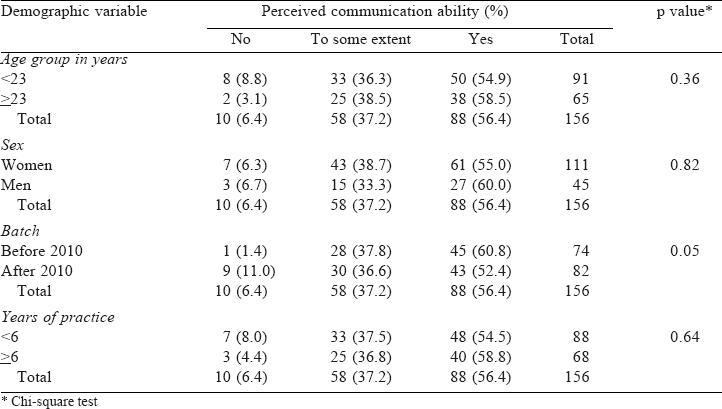Translate this page into:
Students' perceptions of gaps in teaching communication skills and behavioural sciences in undergraduate dental education
2 Department of General Medicine, Mahatma Gandhi Medical College and Research Institute, Sri Balaji Vidyapeeth, Pillayarkuppam, Puducherry, India
3 Department of Psychiatry, Mahatma Gandhi Medical College and Research Institute, Sri Balaji Vidyapeeth, Pillayarkuppam, Puducherry, India
4 Department of Prosthodontics and Crown and Bridge, Mahatma Gandhi Postgraduate Institute of Dental Sciences, Gorimedu, Puducherry, India
Corresponding Author:
Varsha Murthy
Department of Prosthodontics and Implantology, Indira Gandhi Institute of Dental Sciences, Mahatma Gandhi Medical College Campus, Sri Balaji Vidyapeeth, Pondy-Cuddalore Main Road, Pillayarkuppam, Puducherry
India
drvarshamurthy@gmail.com
| How to cite this article: Murthy V, Sethuraman K R, Choudhury S, Shakila R. Students' perceptions of gaps in teaching communication skills and behavioural sciences in undergraduate dental education. Natl Med J India 2017;30:363-364 |
Medical education makes students feel good about their learning as well as prepares them for professional practice; however, if gaps exist between their clinical training and real-life needs for competent practice, the outcomes can be disastrous.[1] Alumni perceptions on adequacy of training in communication skills can help in identifying the gaps in curriculum and making it more authentic to meet the reallife needs for effective doctor–patient interactions.[2]
This cross-sectional study was done after approval from the institutional ethical committee. A 35-item customized questionnaire, based on the undergraduate dental curriculum, was prepared. It consisted of items covering the major competency domain of communication skills. Face and content validity of the questionnaire was done by subject experts and it had good internal consistency (Cronbach alpha score 0.941). An online link for the questionnaire was sent during April–June 2017 through alumni WhatsApp group requesting for feedback on curriculum. A mixed mode approach was used for the study with evaluation of quantitative as well as qualitative parameters. For the data obtained, categorical variables were expressed in proportions and statistical significance was obtained by using the chi-square test.
We found no difference in perception of these skills based on gender, age and years of practice. However, it differed significantly according to the academic year (p=0.05; [Table - 1]). A majority (>75%) of students opined that these skills were important and should be formally taught. Around half of them felt that they were competent to some extent. However, >75% of them felt that they lacked confidence in certain aspects. The comments revealed that many respondents realized the importance of communication skills after completing the course: ‘I learnt dealing with different kinds of patients from my experience and it will be better if students are taught about patient psychology and behaviour towards patients during the course.’

The respondents in our study perceived the need and importance of these skills and were able to recognize specific areas where they lacked adequate skills. Major lacunae in training of erstwhile dental students emerged: (i) vital issues faced by a physician in real-life professional practice such as dealing with dissatisfied and difficult patients, non-verbal communication, basic knowledge of dealing with patients with psychological issues and compliance issues; and (ii) important factors that affect patient satisfaction such as management of anxiety and dental phobia and influence of natural and social environment on health.
Our study showed significant difference according to the batch of the students (pre-2010 v. post-2010). The reason is difficult to ascertain in view of the rapid staff turnover and dependence on informal hidden curriculum to impart these skills.[3],[4] The spurt in the use of information technology since 2012, patients' awareness due to ease of access to knowledge and information and the paucity in experience as compared to their seniors (pre-2010 batch) might have influenced the post-2010 scenario and made the alumni of post-2010 batches feel less confident and competent in the particular areas identified by the questionnaire.
Our study had some limitations, as it did not include the perspectives of employers, alumni of other institutes and comparison of alumni perceptions with those of other stakeholders, namely, the teaching faculty and patients. Studies are needed to document the approach taken by various dental specialties to develop these skills for students, and motivation of faculty staff to impart information in these nonassessed topics and skills.
A customized questionnaire to assess the communication skills of alumni yielded vital information on the gaps between the intended and achieved curriculum, which can help in improving the quality of dental training and education.
Conflicts of interest. None
| 1. | Canadian Medical Association. Physician health and well-being. Can Med Assoc J 1998;158:1191-5. [Google Scholar] |
| 2. | Cohen L, Manion L, Morrison K. Research Methods in Education. 6th ed. London:Routledge; 2007. [Google Scholar] |
| 3. | Kandaswamy D, Anbarasi K. Professional and personal enhancement: A pragmatic approach in dental education. Korean J Med Educ 2016;28:219-29. [Google Scholar] |
| 4. | Donate-Bartfield E, Lobb WK, Roucka TM. Teaching culturally sensitive care to dental students: A multidisciplinary approach. J Dent Educ 2014;78:454-64. [Google Scholar] |
Fulltext Views
1,991
PDF downloads
1,087




